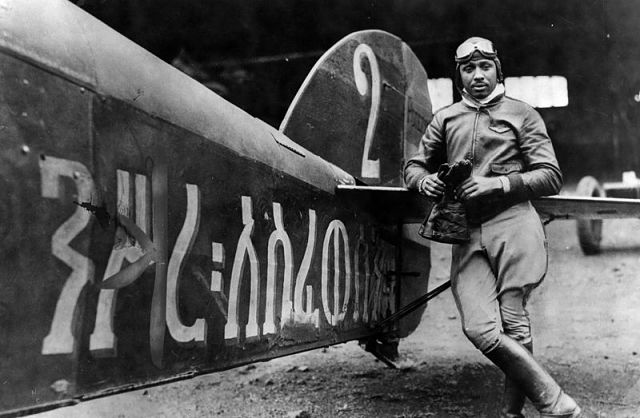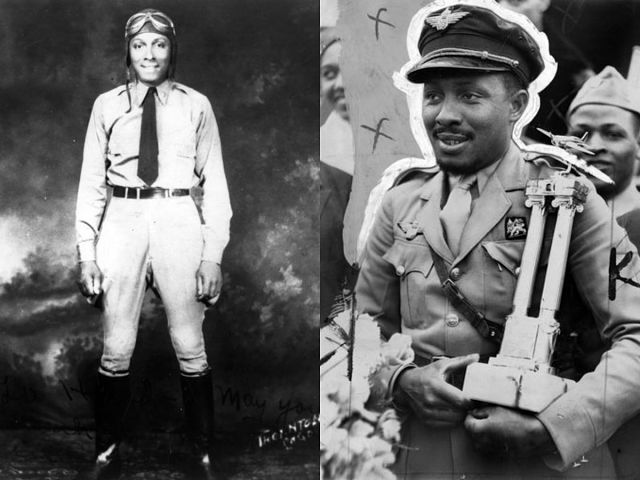 John Robinson of Chicago, circa 1935. The aviator did his part to fight fascists by joining Ethiopia's air force. He is often called the father of the Tuskegee Airmen. After World War II, Robinson returned to Ethiopia to train pilots and organize the country’s national airline — and it’s where he met his fate in 1954. He died following a plane crash in Addis Ababa. He is buried there a hero. He was 50. (Associated Press)
John Robinson of Chicago, circa 1935. The aviator did his part to fight fascists by joining Ethiopia's air force. He is often called the father of the Tuskegee Airmen. After World War II, Robinson returned to Ethiopia to train pilots and organize the country’s national airline — and it’s where he met his fate in 1954. He died following a plane crash in Addis Ababa. He is buried there a hero. He was 50. (Associated Press)
Flashback: Black Chicagoan John C. Robinson Fought Italy’s Fascists as Commander of Ethiopia’s Air Force
As a mayoral commission evaluates dozens of Chicago monuments and statues deemed problematic, it will confront one memorial that has long been the focus of a dispute: the Balbo column in Burnham Park.
The honoree, Italo Balbo, attended Chicago’s 1933 Century of Progress Exposition as Italian Prime Minister Benito Mussolini’s representative. Balbo was a fascist, a leader of the movement’s paramilitary Blackshirts, one of the men who planned the insurrectional March on Rome to install Mussolini as Italy’s dictator and, as colonial governor of Libya, a supporter of Italy’s forced annexation of Ethiopia.
Despite the outcry over Chicago’s recognition of him, the Balbo column remains in place, and Balbo Drive remains Balbo Drive. Perhaps it is time to contextualize Balbo, and there may be no better way than with a monument to a Black Chicagoan: John C. Robinson, commander of Ethiopia’s air force and the man credited with inspiring the Tuskegee Airmen.
“When he was a kid, he stood on the beach and watched the first ‘aeroplane’ land” in Gulfport, Mississippi, a childhood friend of Robinson’s told a local Mississippi newspaper. “Right then he was thrilled with the idea of flying.”

Left: A studio portrait of John Charles Robinson, nicknamed the Brown Condor, shows the pioneer aviator in his flying gear/Smithsonian Institution. Right: Aviator John C. Robinson, of Chicago, is welcomed home [after his return from Ethiopia] in May 1936. Editor’s note: This historical print contains crop marks and hand painting. (Chicago Tribune historical photo)
Robinson, who trained at the Tuskegee Institute to be an automobile mechanic, moved to Chicago in 1927 and soon opened a garage in Bronzeville on 47th Street near Michigan Avenue. He lived close by with his wife, Earnize.
He found ways to indulge his fascination with aviation and build his skills. He established the Brown Eagle Aero Club, a coed group of young African American aviation enthusiasts. He bought a kit for a build-it-yourself airplane and, with the help of friends including Cornelius Coffey, began assembling it in his garage with a retrofitted motorcycle engine. The group eventually moved the project to space at the airport in Melrose Park. Robinson’s contacts there led to his first training as a pilot, and he earned his pilot’s license just a few years after moving to the city.
Despite Robinson’s impressive drive and skills, the Curtiss-Wright Aeronautical University in Chicago rejected his application because it didn’t admit Black students. But that didn’t stop Robinson, who got work as a janitor there. He “was always cleaning classroom floors at lecture time,” absorbing the lessons and also taking notes off the chalkboard when class wasn’t in session, a friend told biographer Phillip Thomas Tucker. The school finally admitted him, and he graduated at the top of his class as a master mechanic in 1931.
Robinson broke the color barrier in other ways. He signed on as the school’s first Black instructor and taught the first all-Black class, which included Coffey. The university’s Black students would become pioneers in aviation and the seeds of the Tuskegee Airmen, the most-storied Black unit in World War II.
Robinson and Coffey teamed up to establish an airport in south suburban Robbins, where they instructed other African Americans in flying, though a brutal windstorm tore it apart. Coffey then set up his own flight school in the southwest suburbs; it trained some 200 African American pilots, many of whom served with the Tuskegee Airmen, either as pilots or in supporting roles. Robinson, for his part, was deeply involved in developing Tuskegee’s aviation program and is often called the father of the Tuskegee Airmen.
Robinson began waging his own fight against fascism much earlier. In 1935, he announced his eagerness to volunteer in Ethiopia, then under imminent threat of an Italian invasion, and drew the attention of Malaku Bayen, a relative of Ethiopia’s emperor. Robinson was granted an officer’s commission and the rank of colonel. He shortly took over as leader of the nation’s air force after the emperor kicked out its volatile commander. Italy invaded a few weeks later. Robinson fought Mussolini’s fascists for a little over a year, suffering wounds in warfare and earning the nickname Brown Condor.
As a Black flyer, Robinson was the subject of worldwide fascination. The African American press in America covered every exploit of the Florida-born and Mississippi-bred pilot.
The Tribune also took notice of his celebrity. In the summer of 1935, a reporter contacted his wife at his auto garage, which she was managing while Robinson was in Ethiopia building up its air force. “She got most of her information about her husband’s activities from the newspapers,” the reporter wrote. The Tribune’s knowledge was only a little more definite: “Recent dispatches from Addis Ababa have described him as chief of the Ethiopian air forces.”
The Ethiopians met the Italians bravely. In October 1935, Robinson gave the emperor “his first airplane flight in many years,” the Tribune wrote, so that he might “wave good-by to 8,000 well equipped troops riding to the northern front from Addis Ababa in American motor trucks.”
The Ethiopians were overmatched, however. The air force flew only a dozen or so aircraft, described in the Tribune as “mediocre scouting planes.” Italian forces acted with impunity. Italy’s air force bombed combatants and civilians with mustard gas, a violation of the Geneva Conventions.
Forced to keep his distance and fly as an observer, Robinson witnessed the Italian bombardment of Adwa, the site of an Ethiopian victory over Italy in the first Italo-Ethiopian War in 1896. “They caught the city asleep and unawares,” he told a news wire service, as reported in October 1935. “Many sought refuge at the Red Cross hospital, imagining they would be protected there. …. The killed and wounded were chiefly in the neighborhood of the hospital.”
Robinson returned to the United States after Italy won the war, exiled the emperor and annexed Ethiopia in May 1936. He received a hero’s welcome. At Municipal (Midway) Airport, the Tribune reported, the crowd broke through police lines to greet him. “He was showered with bouquets by girl members of the Challenger Air Pilots’ association, which Robinson organized.”
Officers with the Eighth Infantry Regiment of the Illinois National Guard and members of the Chicago Society for the Aid of Ethiopia and the Chicago-Tuskegee club were also there to celebrate him.
Police escorted his motorcade to the Grand Hotel at 51st Street and King Drive, where the Brown Condor addressed a crowd of thousands from a balcony. Later, dignitaries including Mayor Edward Kelly toasted him at a dinner in his honor.
The next year, the Chicago Defender recruited the famed pilot to lead its campaign to deliver food and clothing to the victims of catastrophic Mississippi River flooding.
After his return from Africa, Robinson founded a school for aviation and automotive engineering in buildings at Poro College in Bronzeville. Poro’s president, Annie Malone, the cosmetics and hair care magnate, considered it a prestigious addition. Robinson barnstormed across the U.S. to promote it. The federal National Youth Administration took it over and designated it a training center for aviation mechanics, with Robinson as its administrator.
“Brown Condor’s Wings Pinioned by Desk Duties” declared a 1941 Tribune headline. The training center became another feeder into the Tuskegee Airmen.
After World War II, Robinson returned to a liberated Ethiopia to train pilots and organize the country’s national airline — and it’s where he met his fate in 1954. He died following a plane crash in Addis Ababa.
The Brown Condor is buried there, in Africa, a hero. He was 50.
Robinson is not commemorated in Chicago, his adopted hometown. Balbo has a street and a column. Perhaps a monument to Robinson might be commissioned, to be placed opposing Balbo in Burnham or Grant Park. What better way to underscore Balbo’s infamy than to contrast him with the heroism of the Brown Condor?
John Mark Hansen is a professor in political science at the University of Chicago.
—
Related:
Smithsonian: Two Black Aviators & Ethiopia
Join the conversation on Twitter and Facebook.

























